Oakdale Cemetery is a cemetery in Wilmington, North Carolina that dates from the 19th century. [1]
Contents

Oakdale Cemetery is a cemetery in Wilmington, North Carolina that dates from the 19th century. [1]

Because existing cemeteries were becoming crowded, a group of citizens bought a 65-acre tract of land east of Burnt Mill Creek, east of the town limits. [1] The first interment was Annie DeRosset, age 6, on February 5, 1855. Her father, John DeRosset, was a physician and the first president of the cemetery corporation. [1]
The cemetery has an enclosed Hebrew Cemetery, dating from 1855, as well as a Masonic section, at least one section for Odd Fellows, a section where the burials formerly at Front Street Methodist church were moved after an 1886 fire and a section for those with no other family. [1]

Along with regular grave sites for Confederate soldiers, a great burial mound was erected by the United Daughters of the Confederacy for the dead Confederate soldiers from the Second Battle of Fort Fisher. Dedicated in 1872, a bronze statue of a regular soldier stands atop a large circular stone base. The dedication plaque reads,
"THIS MONUMENT WAS DEDICATED MAY 10, 1872 / TO PERPETUATE DEEDS OF THE BRAVE AND IN GRATEFUL / TRIBUTE TO THE MEMORY OF 550 HONORED UNKNOWN / CONFEDERATE DEAD AT THE BATTLE OF FORT FISHER / WHO LIE BURIED HERE / SPONSORED BY THE LADIES MEMORIAL ASSOCIATION LATER MERGED WITH DAUGHTERS OF THE CONFEDERACY / SELF DENIAL - WORK - PRAYERS - TEARS - HEARTS BLOOD / ENTERED INTO ITS BUILDING"
.
According to the University of North Carolina, as many as 367 unknown dead soldiers are buried under the mound. [2]

The Second Battle of Fort Fisher was a successful assault by the Union Army, Navy and Marine Corps against Fort Fisher, south of Wilmington, North Carolina, near the end of the American Civil War in January 1865. Sometimes referred to as the "Gibraltar of the South" and the last major coastal stronghold of the Confederacy, Fort Fisher had tremendous strategic value during the war, providing a port for blockade runners supplying the Army of Northern Virginia.

The parish of Trinity Church has three separate burial grounds associated with it in New York City. The first, Trinity Churchyard, is located in Lower Manhattan at 74 Trinity Place, near Wall Street and Broadway. Alexander Hamilton, Albert Gallatin, and Robert Fulton are buried in the downtown Trinity Churchyard.

Bellefontaine Cemetery is a nonprofit, non-denominational cemetery and arboretum in St. Louis, Missouri. Founded in 1849 as a rural cemetery, Bellefontaine is home to a number of architecturally significant monuments and mausoleums such as the Louis Sullivan-designed Wainwright Tomb, which is listed on the National Register of Historic Places.

Hollywood Cemetery is a large, sprawling cemetery located next to Richmond, Virginia's Oregon Hill neighborhood at 412 South Cherry Street. Characterized by rolling hills and winding paths overlooking the James River, it is the resting place of two United States Presidents, James Monroe and John Tyler, as well as the only Confederate States President, Jefferson Davis. It is also the resting place of 28 Confederate generals, more than any other cemetery in the country; these include George Pickett and J.E.B. Stuart.
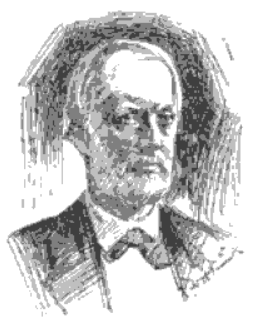
Edwin Godwin Reade was a U.S. congressman from North Carolina between 1855 and 1857. He later served in the Confederate Senate during the American Civil War.

Fort Fisher was a Confederate fort during the American Civil War. It protected the vital trading routes of the port at Wilmington, North Carolina, from 1861 until its capture by the Union in 1865. The fort was located on one of Cape Fear River's two outlets to the Atlantic Ocean on what was then known as Federal Point or Confederate Point and today is known as Pleasure Island. The strength of Fort Fisher led to its being called the Southern Gibraltar and the "Malakoff Tower of the South". The battle of Fort Fisher was the most decisive battle of the Civil War fought in North Carolina.

Mount Olivet Cemetery is a 206-acre (83 ha) cemetery located in Nashville, Tennessee. It is located approximately two miles East of downtown Nashville, and adjacent to the Catholic Calvary Cemetery. It is open to the public during daylight hours.

The Confederate Memorial at Indian Mound Cemetery in Romney, West Virginia, commemorates residents of Hampshire County who died during the American Civil War while fighting for the Confederate States of America. It was sponsored by the Confederate Memorial Association, which formally dedicated the monument on September 26, 1867. The town of Romney has claimed that this is the first memorial structure erected to memorialize the Confederate dead in the United States and that the town performed the nation's first public decoration of Confederate graves on June 1, 1866.

Lexington Cemetery is a private, non-profit 170-acre (69 ha) rural cemetery and arboretum located at 833 W. Main Street, Lexington, Kentucky.
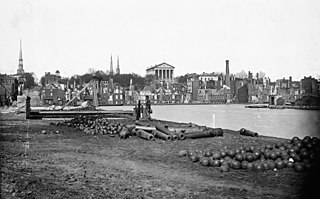
Richmond, Virginia served as the capital of the Confederate States of America during the American Civil War from May 8, 1861, hitherto the capital had been Montgomery, Alabama. Notwithstanding its political status, it was a vital source of weapons and supplies for the war effort, as well as the terminus of five railroads, and as such would have been defended by the Confederate States Army at all costs.

Oakwood Cemetery is a large, city-owned burial ground in the East End of Richmond, Virginia. It holds over 48,000 graves, including many soldiers from the Civil War.

The McGavock Confederate Cemetery is located in Franklin, Tennessee. It was established in June 1866 as a private cemetery on land donated by the McGavock planter family.

Loudon Park Cemetery is a historic cemetery in Baltimore, Maryland. It was incorporated on January 27, 1853, on 100 acres (40 ha) of the site of the "Loudon" estate, previously owned by James Carey, a local merchant and politician. The entrance to the cemetery is located at 3620 Wilkens Avenue.
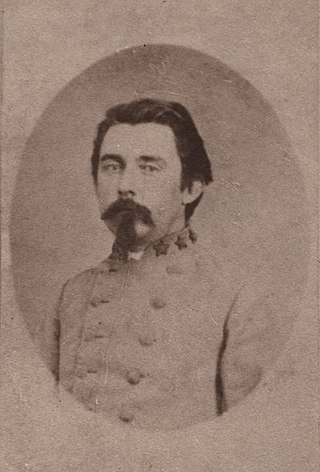
Thomas Stephen Kenan was an American lawyer, Confederate soldier and politician. He served as the Attorney General of North Carolina in 1877–1885.

A Ladies' Memorial Association (LMA) is a type of organization for women that sprang up all over the American South in the years after the American Civil War. Typically, these were organizations by and for women, whose goal was to raise monuments in Confederate soldiers honor. Their immediate goal, of providing decent burial for soldiers, was joined with the desire to commemorate the sacrifices of Southerners and to propagate the Lost Cause of the Confederacy. Between 1865 and 1900, these associations were a formidable force in Southern culture, establishing cemeteries and raising large monuments often in very conspicuous places, and helped unite white Southerners in an ideology at once therapeutic and political.
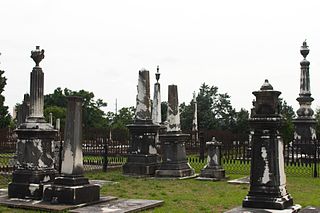
The Old City Cemetery, also known as Linwood Cemetery, is a 28.7-acre (11.6 ha) cemetery on what is now Linwood Boulevard, in Columbus, Georgia. It dates from 1828, when the town of Columbus was founded, or before. It appears in surveyor Edward Lloyd Thomas's original plan for the city. The cemetery consists mostly of rectangular family plots bordered by iron fences or walls made of brick or granite, accessed by a main east-west corridor and perpendicular lanes. It includes both simple and elaborate tombstones, some displaying Egyptian Revival or Gothic styles.
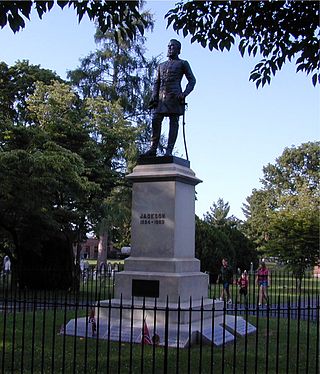
The Oak Grove Cemetery, originally known as the Presbyterian Cemetery, is located on South Main Street in downtown Lexington, Virginia, less than a mile from the campuses of Washington and Lee University and the Virginia Military Institute. The cemetery was renamed in 1949 as the Stonewall Jackson Memorial Cemetery after the Confederate general, who was buried here in 1863. The current name dates to September 3, 2020. Also buried here are 144 Confederate veterans, two Governors of Virginia, and Margaret Junkin Preston, the "Poet Laureate of the Confederacy".
Sarah Graham Kenan was an American heiress and philanthropist. She inherited a third of her sister's share of the Standard Oil fortune in 1917 and established the Sarah Graham Kenan Foundation. Through her foundation, Kenan contributed financially to various institutions including the Episcopal Diocese of East Carolina, the University of North Carolina, Duke University, Saint Mary's School, and the Duplin County Board of Education. Her home, located in the Market Street Mansion District in Wilmington, North Carolina, now serves as the official residence of the chancellor of the University of North Carolina at Wilmington. In 1930, through an endowment she made, the Southern Historical Collection was established at the University of North Carolina at Chapel Hill.
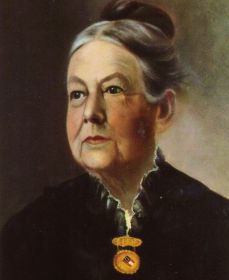
Eliza Hall "Hallie" Nutt Parsley was an American civic leader and educator. She worked as a school teacher after the American Civil War and established her own school for children in Wilmington, North Carolina in 1894. A war widow, she was active in glorifying the Confederacy through her role as a member of the Ladies' Memorial Association, raising money to build Confederate monuments in North Carolina. Parsley became a prominent figure within the United Daughters of the Confederacy, establishing the Cape Fear Chapter in 1894 and the North Carolina Division in 1897. She served as president of the North Carolina Division of the United Daughters of the Confederacy for two years, travelling across North Carolina to recruit new members and promote the pseudohistorical narrative of the Lost Cause of the Confederacy. Under her leadership, in 1898, the Cape Fear chapter established the Cape Fear Museum of History and Science.